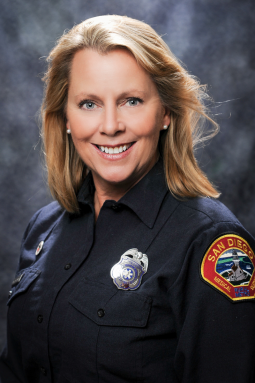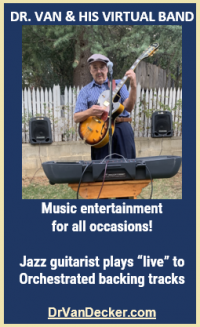
East County wife and mother says the life-saving devices should be easier to find than a gourmet cup of coffee
By Lora Watters
February 27, 2018 (San Diego’s East County) -- Something caught Susanne de La Flor's eye as she strolled through Grossmont Center last spring. It was not a display for a best-selling author in the Barnes & Noble window, nor a life-size cardboard cutout promoting a funny animated movie at Reading Cinemas. It was an Automated External Defibrillator on a plain gray stucco wall, between the post office and CVS Pharmacy located adjacent to the popular East County mail.
Ever since her husband of 26 years, George de la Flor, suffered sudden cardiac arrest and subsequent brain damage in 2011, Susanne has always made note of AED devices in public places. But there was something special about this AED. It was located outside.
Immediately Susanne recalled the day in June 2011 when George, a civil litigation attorney with a practice located in La Mesa Village, collapsed while working out in a hotel gym on a family vacation to Florida.
"When I got to the gym, I saw my wonderful husband lying there lifeless," Susanne recounts. Fortunately, one other person was working out at the gym that day – a surgeon who began giving George CPR. He was able to keep George alive, but unable to restore consciousness. "The doctor kept screaming for an AED, but there wasn’t one in the gym," Susanne says. "It took an hour and a half for the paramedics to arrive – the longest 90 minutes of my life."
George survived through those long 90 minutes, and after spending six weeks in the ICU, he and Susanne returned to their Mt. Helix home. However, life would never be the same for the couple and their then-teenage sons. Due to the extensive delay to get a defibrillator to him, George had suffered what is known as an "anoxic brain injury," resulting in severe impairment to his short-term memory. The injury forced him to end his law career – the only job he ever wanted.
"This was an extremely difficult adjustment for a man whose previous memory was a steel trap," Susanne says. "Had there only been an AED installed at that gym, where there certainly should have been one, it would have meant all the difference in the world for George and our family." (photo, right: George and Susanne de La Flor)
On its website at www.Heart.org , the American Heart Association explains that AEDs allow bystanders to help in a cardiac event where defibrillation may be needed. The units are portable, and people outside the medical industry, including first responders, can use them. At redcross.org, the American Red Cross even notes there is liability protection for people who rescue others with an Automated External Defibrillator, through the Federal Cardiac Arrest Survival Act of 2000, and through specific AED laws and regulations in all 50 states.
The American Heart Association also notes that calling 911, giving CPR, and using an AED can be combined to improve survival from a sudden cardiac arrest, like the one George went into in the Florida gym.
Back at home, with George needing to close his law practice, it was now up to Susanne to provide the family's income. Having worked such varied jobs in the past as a circus performer, makeup artist, and the office manager in George's firm, the gregarious redhead found a new career as an account executive in litigation support services.
Always one to turn negatives into positives, Susanne then set out to prevent the cardiac tragedy that permanently changed th e de la Flor family from happening to other families. She became an advocate for heart health, SCA and heart attack prevention, and especially, for greater placement of those defibrillators that might have made a full recovery for George possible.
e de la Flor family from happening to other families. She became an advocate for heart health, SCA and heart attack prevention, and especially, for greater placement of those defibrillators that might have made a full recovery for George possible.
"I would like to see mandatory placement of heart defibrillators in every business across the U.S., and in key locations such as on busy streets and public gathering places," she says. "This will create a lifeline for people who need them in a cardiac emergency, like that moment my husband did."
Which brings us back to that AED in Grossmont Center. While you see many defibrillators installed inside stores, gyms, and public buildings around San Diego County, you rarely find them outside. The outdoor device at the mall prompted Susanne to launch a social media challenge. Sort of her own cardiac version of The Bucket Challenge, she asked her Facebook followers to post a picture of any outdoor defibrillator in San Diego County, and even offered $20 as a reward for each post. Though she received many likes and comments, no one found an external AED in addition to that one in Grossmont Center.
"One friend said if she found an outdoor AED, she would post it and not take the $20, and my son asked if the contest was open to family members as well," Susanne says with a laugh. "But unfortunately no one posted an outside AED in San Diego County."
Susanne stresses it's important to have AEDs outdoors because there they can be seen easier, and they will be available in the event a heart emergency occurs after business hours.
"What if the store is closed?" she says. "Does cardiac arrest only happen between 9 a.m. and 5 p.m.?" Susanne would like people to find an AED just as easily as they seem to find Starbucks store nowadays: on every other block. The Red Cross echoes these sentiments, saying on its website that all Americans should be no more than four minutes away from a defibrillator, and a person trained in its use.
Over the past seven years, Susanne has been campaigning for AEDs to be placed in San Diego's outdoor areas with high foot traffic, or where large public events, like concerts or street fairs, occur. Similarly, heart.org suggests that the devices "be placed in public areas such as sports venues, shopping malls, airports, airplanes, businesses, convention centers, hotels, schools and doctors’ offices. They should also be in any other public or private place where large numbers of people gather or where people at high risk for heart attacks live."
On its website, the American Red Cross says that sudden cardiac arrest can happen to people of all ages at any time, and that using a defibrillator is the only effective way to restore the heart to its normal rhythm during SCA.
AEDs in East County
Therefore, since February is American Heart Month, our magazine staff wondered where AED devices are located in East County. Like Susanne, we are curious to know if they are available if a cardiac event occurs after business hours, or during one of our many large, outdoor public events, like street fairs, concerts, movie screenings and more? How easily could readers find defibrillators if a loved one were having cardiac arrest, like George de la Flor?
The city of Santee, which hosts such large outdoor events as the Summer Concert Series and the July Fourth Santee Salutes at Town Center Community Park East, brings a portable AED to all city-sponsored events, says Jon Shellhammer, special events coordinator with the city.
"It's located in our information booth, which is where event patrons go to find information, and is centrally located," he says. However, though Santee has AEDs in its indoor buildings, like City Hall, none are permanently installed outdoors, says Justin Matsushita, B-Division Battalion Chief with the Santee Fire Department.
"We have a significant number of AEDs located throughout the city affixed indoors, particularly our public facilities and our assembly occupancy buildings," Matsushita says in an email. "We just don’t affix them outdoors due to the cost of the units, and the potential of theft and vandalism."
Rather than bring a portable AED to its events, the city of El Cajon uses emergency medical technicians for its public events and street fairs, says a woman who answered the phone at the city's recreation department. She refused to give her name for our story, but added that the EMTs have medical equipment in their ambulances, and that the number of EMTs staffing an event depends its the size.
"We have several AEDs throughout the city of El Cajon public building, but they are indoor," says Brian Hayward, Battalion Chief-EMS with Heartland Fire & Rescue, which serves the cities of El Cajon, La Mesa and Lemon Grove. In an email, he writes that El Cajon has no AEDs outside, other than one at the Fletcher Hills Pool – which is only accessible when the pool is open. Hayward also notes no outside AEDs are available to the public in the cities of La Mesa or Lemon Grove, other than that unit on the wall at Grossmont Center.
La Mesa's quaint downtown village area is host to several public events, like classic car shows, Holiday in the Village, and a large Oktoberfest – and was where George de la Flor's law practice was located. Aaron Dean, chair of the La Mesa Village Association that organizes these events, says paramedics are on site for the Oktoberfest, which is attended by 100,000 people annually.
"For the other events we don't have paramedics, since they are smaller events," he says, adding that no permanent defibrillators are installed outside in the La Mesa Village area. Outside the village, Becky Jackman, recreation supervisor, aquatics/sports, for the city of La Mesa, says in an email that, "the city has AEDs inside several city facilities, but we do not have any outdoor AEDs in place for the public to use."
Like the other East County cities, Lemon Grove also has no outdoor AEDs, says Cassandra Mendenhall, executive assistant for the city of Lemon Grove. "But we do have them in three locations: Lemon Grove Fire Station, Lemon Grove City Hall and the Lemon Grove Community Center," she adds.
 At the county level, a program called San Diego Project Heart Beat has been placing AEDs all over San Diego since 2001, when they first became available for public use. Maureen O’Connor, SDPHB's public access defibrillation program manager (photo, left), says the successful, countywide program was the first of its kind, and aims to increase cardiac arrest survival rates.
At the county level, a program called San Diego Project Heart Beat has been placing AEDs all over San Diego since 2001, when they first became available for public use. Maureen O’Connor, SDPHB's public access defibrillation program manager (photo, left), says the successful, countywide program was the first of its kind, and aims to increase cardiac arrest survival rates.
"AEDs were created for the public to use, not necessarily emergency responders, who have more advanced equipment," she says. "I'm happy to report there are several outdoor AEDs in San Diego County, and several sites that are 24 hours," she says, mentioning units located at Balboa Park and SDSU. Specific to East County, O'Connor says SDPHB recently placed a defibrillator in Mt. Helix Park, which is available during business hours inside the center for Mt. Helix Park.
"Our mission is to make AEDs as accessible as fire extinguishers," she says. "In your lifetime, you will be much more likely to use an AED than a fire extinguisher. It's super-important to educate society to recognize cardiac arrest symptoms, call 911 and know hands-only CPR."
Since its inception, SDPHB has placed more than 9,000 AEDs throughout the community, and saved 164 lives, two of which were children at Grossmont Union High School District. O'Connor says SDPHB will continue to place the defibrillators, and would like to get AEDs in the hands and in the vehicles of sheriffs, rangers, and first responders who could help someone having a cardiac arrest outside in East County.
"We have a Grant Assistance Fund that people could donate to, to help place more AEDs in nonprofit arenas to help save more lives," she says. "For example in East County, these could be campgrounds and lake recreation centers. 100 percent of the money goes to placing AEDs in nonprofit locations."
O'Connor also mentions the PulsePoint smartphone application, available for all of San Diego County, at pulsepoint.org. The app shows where cardiac arrests are occurring, and if a user agrees to help someone in SCA, displays where all public AEDs are currently placed nearby.
"Someone can then go and get the AED, while another gives hands-only CPR," O'Connor says, adding that the app is managed under each municipal fire department. Similar to Susanne's Facebook challenge, PulsePoint users can also upload pictures of AEDs located in the City of San Diego.
"All people within in San Diego County who have a smartphone should have this free app on their phone," O'Connor says. "We're doing the best we can in this world for cardiac arrest victims." O'Connor herself lost a 41-year-old niece to cardiac arrest, and like Susanne, strives to educate the public about AED awareness and use.
"Because of what happened to George, we have worked hard to prevent this kind of tragedy from happening to others in the future – by spreading awareness of cardiac arrest risks and by advocating for better AED placement," Susanne says. "We will keep fighting to get more defibrillators placed outside."
The outdoor AED challenge is still open on her Facebook – so be on the lookout for one of the devices the next time you're out enjoying the outdoors. It might just net you $20. And more importantly, it might just save a life.














Recent comments